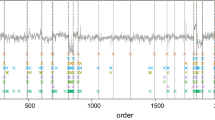Abstract
The concept of the spectral envelope was introduced as a statistical basis for the frequency domain analysis and scaling of qualitative-valued time series. A major focus of this research was the analysis of DNA sequences. A common problem in analyzing long DNA sequence data is to identify coding sequences that are dispersed throughout the DNA and separated by regions of noncoding. Even within short subsequences of DNA, one encounters local behavior. To address this problem of local behavior in categorical-valued time series, we explore using the spectral envelope in conjunction with a dyadic tree-based adaptive segmentation method for analyzing piecewise stationary processes.
Similar content being viewed by others
References
Adak, S. (1998). Time dependent spectral analysis of nonstationary time series, J. Amer. Statist. Assoc., 93, 1488–1501.
Breiman, L., Friedman, J., Olshen, R. and Stone, C. (1984). Classification and Regression Trees, Wadsworth and Brooks/Cole, Monterey, California.
Brillinger, D. R. (1981). Time Series: Data Analysis and Theory, 2nd ed., Holden-Day, Oakland, California.
Chiann, C. and Morettin, P. (1999). Estimation of time varying linear systems, Statistical Inference for Stochastic Processes, 2, 253–285.
Coifman, R. and Wickerhauser, M. (1992). Entropy based algorithms for best basis selection, IEEE Trans. Inform. Theory, 32, 712–718.
Cornette, J. L., Cease, K. B., Margaht, H., Spouge, J. L., Berzofsky, J. A. and DeLisi, C. (1987). Hydrophobicity scales and computational techniques for detecting amphipathic structures in proteins, Journal of Molecular Biology, 195, 659–685.
Dahlhaus, R. (1997). Fitting time series models to nonstationary processes, Ann. Statist., 25, 1–37.
Dahlhaus, R. (1999). A likelihood approximation for locally stationary processes, Beiträge zur Statistik 56, Universität Heidelberg.
Donoho, D., Mallat, S. and von Sachs, R. (1998). Estimating covariances of locally stationary processes: Rates of convergence of best basis methods, Tech. Report 517, Department of Statistics, Stanford University.
Eaton, M. L. and Tyler, D. E. (1991). On Wielandt's inequality and its application to the asymptotic distribution of the eigenvalues of a random symmetric matrix, Ann. Statist., 19, 260–271.
Hannan, E. J. (1970). Multiple Time Series, Wiley and Sons, New York.
Ioshikhes, I., Bolshoy, A. and Trifonov, E. N. (1992). Preferred positions of AA and TT dinucleotides in aligned nucleosomal DNA sequences, Journal of Biomolecular Structure and Dynamics, 9, 1111–1117.
Karlin S. and Macken, C. (1991). Some statistical problems in the assessment of inhomogeneities of DNA sequence data, J. Amer. Statist. Assoc., 86, 27–35.
Mallat, S., Papanicolau, G. and Zhang, Z. (1998). Adaptive covariance estimation of locally stationary processes, Ann. Statist., 26, 1–17.
Muirhead, R. J. (1982). Aspects of Multivariate Statistical Theory, Wiley, New York.
Ombao, H., Raz, J., von Sachs, R. and Malow, B. (2001). Automatic statistical analysis of bivariate nonstationary time series, J. Amer. Statist. Assoc., 96, 543–560.
Rosenblatt, M. (1959). Statistical analysis of stochastic processes with stationary residuals, Probability and Statistics (ed. U. Grenander), 246–275, Wiley, New York.
Satchwell, S. C., Drew, H. R. and Travers, A. A. (1986). Sequence periodicities in chicken nucleosome core DNA, Journal of Molecular Biology, 191, 659–675.
Stoffer, D. S., Tyler, D. E. and McDougall, A. J. (1993a). Spectral analysis for categorical time series: Scaling and the spectral envelope, Biometrika, 80, 611–622.
Stoffer, D. S., Tyler, D. E., McDougall, A. J. and Schachtel, G. (1993b). Spectral analysis of DNA sequences (with discussion). Bulletin of the International Statistical Institute, Bk I, 345–361 (Discussion: ibid. (1994). Bk IV, 63–69).
Tiwari, S., Ramachandran, S., Bhattacharya, A., Bhattacharya, S. and Ramaswamy, R. (1997). Prediction of probable genes by fourier analysis of genomic sequences, Computer Applications in the Biosciences, 13, 263–270.
Tyler, D. E. (1981). Asymptotic inference for eigenvectors, Ann. Statist., 9, 725–736.
Voss, R. (1992). Evolution of long-range fractal correlations and 1/f noise in DNA base sequences, Phys. Rev. Lett., 68(25), 3805–3808.
Wickerhauser, M. (1994). Adapted Wavelet Analysis from Theory to Software, IEEE Press, Wellesley, Massachusetts.
Author information
Authors and Affiliations
About this article
Cite this article
Stoffer, D.S., Ombao, H.C. & Tyler, D.E. Local Spectral Envelope: An Approach Using Dyadic Tree-Based Adaptive Segmentation. Annals of the Institute of Statistical Mathematics 54, 201–223 (2002). https://doi.org/10.1023/A:1016182125278
Issue Date:
DOI: https://doi.org/10.1023/A:1016182125278




